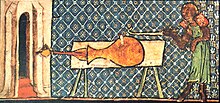Fire pot (gun)


A fire pot , also known as an arrow box ( French pot de fer "iron pot"), is an early medieval cannon , with which mainly arrow-like projectiles were fired.
history
Firearms first appeared in Europe at the turn of the 13th and 14th centuries . The concept of the gun powered with gunpowder came from the Chinese region to Europe via the trade routes of Arabia (see for example the so-called "Heilongjiang gun").
Initially, bronze casting was used to produce suitable rifle barrels. The ammunition was initially a kind of oversized crossbow bolts (called "rifle arrows", contemporary: "Sprite" or "Springel"), the shafts of which were wrapped in the back with a metal disk as a sabot . Cannon balls made of stone or lead were later used. Stone cannonballs were cheaper and on impact, stone fragments flew around the target area as a side effect. The fire pot was ignited via an ignition hole using a matchstick . The range of the shot tested in experiments with a rifle arrow was around 250 m, with a lead bullet around 600 m. Arrows and bullets pierced iron plates of 1.5 mm thickness set up at a distance of 20 m with ease.
The oldest pictorial representation of a fire pot is considered to be the one in the English manuscript De Notabilitatibus, Sapientiis et Prudentia Regum by Walter de Milemete from 1326. It shows a cannon in the form of a bulbous, narrow-necked vase, which is mounted on a four-legged wooden frame ( carriage ) , has loaded a rifle arrow as ammunition and is detonated.
The first demonstrable use of firearms in Germany took place during the siege of Eltz Castle during the Eltz feud from 1331 to 1336 with arrow rifles. It was from 1975 to 1981 during restoration work Eltz Castle alongside 23 major Blidenkugeln a box arrow on the western outer bailey , which was most under attack found. With the possibility of dating the Eltz feud, it is the oldest known evidence of the use of this weapon in Germany.
A bronze fire pot about 30 cm long found near Loshult in what is now southern Sweden in 1861, the creation of which is dated to the 14th century, gives a suitable impression of the shape of early arrow boxes. This find is called Loshult rifle because of its location and also illustrates the probably immeasurably oversized representation of the arrow rifles in the Milemete manuscripts. Correspondingly, various reconstructions (see illustrations) created using the mileage manuscripts can also be addressed as oversized.
See also
literature
- Walter de Milemete: De Notabilitatibus, Sapientiis et Prudentia Regum . 1326.
- Hans-Christian Huf: Quo Vadis: Fateful Hours of Humanity . Gustav Lübbe, Bergisch Gladbach 1997, ISBN 3-7857-0877-7 , p. 278-283 .
- Wilfried Tittmann: The Eltzer rifle arrows from 1331-1333 . In: weapons and costume studies . tape 36 , 1994, ISSN 0042-9945 , pp. 117–128 ( Online [PDF; 5.7 MB ]).
- Wilfried Tittmann: The Eltzer feud from 1331-1333 . In: weapons and costume studies . tape 37 , 1995, ISSN 0042-9945 , pp. 53-64 .
- Jochen Gartz: From Greek fire to dynamite. A cultural history of explosives . ES Mittler & Sohn, Hamburg 2007, ISBN 978-3-8132-0867-2 .
Web links
Individual evidence
- ↑ http://www.visier.de/2476.html Visier - The international weapons magazine - The arrow-shaped projectile was also called "Sprite" or "Springel" in the parlance of those years , July 6, 2005
- ↑ Klaus Leibnitz: Büchsenmeisterei, that is the art of properly producing gunpowder, loading rifles with it and shooting with it, proven by experiments that were made with a replica of the Loshult rifle . In: weapons and costume studies . No. 2 , 2002, p. 127-154 .
- ^ Wilfrid Tittmann: The Eltzer rifle arrows from 1331-1333. In: Waffen- und Costumekunde, Volume 36 (1994), pp. 117-128, Volume 37 (1995), pp. 53-64
- ↑ Main mass of the Loshult pipe ( Memento from February 7, 2014 in the Internet Archive ) (PDF; 2.7 MB)
- ^ Wilfried Tittmann: The gun depictions of Walter de Milemète from 1326/7. Ruhr-Uni Bochum, 2011, accessed on February 27, 2019 .
